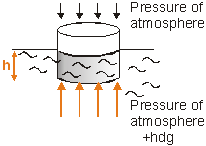Topic: Buoyancy
Teacher Notes (Refer to
student sheet for lab worksheet)
Objectives:
- Define
Buoyancy
- Measure
Buoyant force
Concept:
It is common knowledge that objects are lighter in water
than in air. When an object is fully or partially immersed in a fluid it
experiences an apparent loss in weight. In this experiment you will investigate
buoyancy.
Historical background:
The Greek Mathematician and inventor Archimedes is the
father of the Principle of Buoyancy. History has it that he discovered the
principle of buoyancy while he took his bath one day in his bathtub. He noticed
that as he lowered himself into the bath the water from the bath overflowed the
sides and found that there was a relationship between his weight in the tub and
the volume of water displaced. At this discovery he ran out of his bathtub into
the streets yelling “heurEka” meaning, “I found it”. This principle has
since been applied in the building of ships and air balloons. He is credited
with proving that the King’s crown smith had been ripping off the king in
doping his gold crown with silver.
National Science Standard addressed:
Physical Science - A- Properties and structure of matter, Students will observe
balanced and unbalanced forces and the resulting motion of an
object.
Science as Inquiry - Students will collect observational data and think
critically about cause and effect relationships.
Missouri Grade Level Expectation
by the lesson: Science Strand 1.1a Properties and states of matter, Strand
2.2a,b,c Forces as contact forces - pull, push, buoyancy.
Materials
- Rocks
(8)
- Measuring
Cylinders (8)
- String
- Spring
balances (8)
- Clear
container (8)
- Water
- Aluminum
bowls (8)
Instructions
Students will work in groups of two. Each group will be
provided with the above listed materials.
Reasoning Strategies:
1. Induction
2. Investigation
Lab 1
Step1:
Use the spring balance provided to measure the weight of
the object provided in air and record the weight.
Weight in Air = ________________ N
Step2:
Pour some water in the measuring cylinder provided, about
2/3 way full, and record its volume.
Volume of water = ______________ CC
Immerse the object provided in the water.
What do you notice about its weight?
_________________________________
Now read off
its weight and record it. Also record the new water level.
Weight of Object in water = __________________ N
New volume of water = ____________________ CC
Difference in Weight: _____________________ N
Lab 2
- Factors affecting Buoyancy
In this lab students will place the object provided, stone
in our case, in a bowl of water and observe what happens. It will sink. They
then put this stone in an aluminum bowl and place the bowl in water. Now it
floats. This behavior should be explained using the idea of density of the
system of the stone and the aluminum bowl. the increase in surface area of the
system increases the volume of the system and reduces its density, hence it
floats.
_____________________________________
Concept Development:
Questions: Through teacher led questions and answers groups discuss their
findings.
Teacher summary:
The activity shows that the object weighed more in air than
in water. Objects in any fluid experience an upward push or force known as
Buoyant Force. Buoyant force is a result of unbalanced forces acting on the
object in the fluid from all directions. This buoyant force is equal to the apparent loss in weight of the
object. The buoyant force experienced by a body can be affected by its size
(surface area) and weight. We found in lab 2 that the object sank when placed in
water by itself, but floats when placed in the foil bowl. This is also a good
time to introduce Archimedes Principle which states that an object that is
partially or fully immersed in a fluid displaces an amount of fluid equal to its
weight. Students should also be informed that Archimedes Principle is also
described as the law of Buoyancy.

What do you think is the reason why it did not sink while
in the bowl?
Application: The concept
of buoyancy and the principle of Archimedes can be applied in finding the volume
of an irregular object. First the object is weighed in air using a triple beam
balance, then when submerged in water. Since a submerged object displaces its
volume of the fluid in which it is submerged, the apparent
loss in mass in grams is equal to the volume of the irregular object in cubic
centimeters since water
has a density of 1g/cc, which means that 1gram of water has a volume of 1 cubic centimeter.
References:
- Douglas
Llewellyn. (2002) Inquire Within.
- Paul
G. Hewitt. (2002) Conceptual Physics: a High School Physics Program. Ma:
Prentice Hall.
Historical background
http://www.bible-history.com/resource/ff_float.htm
Application
http://hyperphysics.phy-astr.gsu.edu/hbase/pbuoy2.html#arc
Further reading
http://hyperphysics.phy-astr.gsu.edu/hbase/dens.html#dens
http://hyperphysics.phy-astr.gsu.edu/hbase/pbuoy.html#buoy
http://www.plus2physics.com/hydrostatics/study_material.asp?chapter=3
Fun Activities for
a follow-up lesson
http://www.pbs.org/saf/1503/teaching/teachPDF.pdf
http://www.juliett484.org/juliett/education/science/cartesian_diver.html
